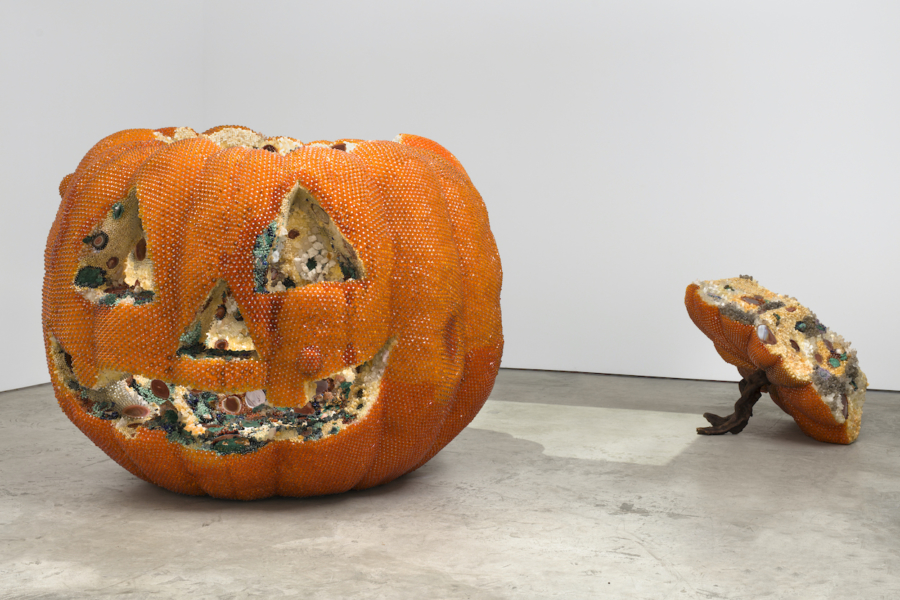June 16, 2021
Download as PDF
View on Art in America

Kathleen Ryan, Jackie, 2021, azurite-malachite, lapis lazuli, agate, black onyx, breccicated jasper, moss agate, malachite, calcite, labradorite, rose quartz, smokey quartz, ching hai jade, red aventurine, carnelian, citrine, amethyst, quartz, acrylic, polystyrene, fiberglass, nails, steel pins, wood, 66 by 90 by 86 in. COURTESY THE ARTIST AND KARMA, NEW YORK.
For her second solo show in New York, Kathleen Ryan presents a total of ten sculptures in Karma’s two East Village galleries. Several recent sculptures from the artist’s 2018– “Bad Fruit” series—including three lemons and four cherries, two of them conjoined—rest on pedestals in the smaller venue. Oversize and encrusted with semiprecious stones that convincingly simulate spreading mold, the sculptures reinforce the vanitas motifs found in much of Ryan’s work to date, efficiently merging symbols of fleeting sensual pleasure and material wealth.
Although Ryan’s sculptures share thematic ground with seventeenth-century Dutch still life paintings, their morphological origins lie elsewhere, in the beaded fruit kits marketed to homemakers in postwar America. By pinning plastic beads and sequins onto Styrofoam balls, crafty consumers could easily create glittering replicas of ripe fruit for tabletop displays. While remaining faithful to that basic technique, Ryan carves much larger polystyrene armatures for her sculptures, vastly increases the number of pinned elements, and supplements acrylic beads with all manner of semiprecious stones, which are catalogued in her checklists. These upgrades facilitate a remarkable degree of detail and realism, especially where the multicolored gems suggest patches of microbial growth. Given that many vintage beaded fruits were once treasured tchotchkes that now gather dust on thrift store shelves, Ryan’s faux fungi not only imply the passage of time, but also seem to manifest the nostalgia that can cling to the kitsch object.
That Ryan’s work enlarges and elevates homemade decor is more apparent in Karma’s larger gallery, where the artist installed Jackie (2021), an enormous rendition of a jack-o’-lantern measuring more than seven feet across, its overturned lid displayed to the side. Studded with tens of thousands of orange acrylic beads, this crudely carved pumpkin sits in a state of post-Halloween putrescence. Peering through its facial features, one glimpses a veritable grotto of minerals mimicking mold; numerous purple-brown agate slices resemble lesions, indicating advanced decay. Unlike most of the “Bad Fruit” sculptures, where the bejeweled rot is externalized, the gutted rind of Jackie offers emphatic inside/outside contrasts while scrambling other binaries such as nature and artifice, mineral and vegetable, fine art and lowbrow craft.
Other ambitious sculptures in this show include Bad Cherries (2021), which corrals dozens of the titular fruits in a steel pallet cage that doubles as a jumbo grocery basket. A pearlescent mildew appears to have migrated from cherry to cherry, threatening to spoil the entire parcel. As in Ryan’s other cherry sculptures, the stems are fashioned from the tapering ends of fishing rods, each weighted with a lead sinker. While the tilting rods neatly describe the elegant arcs of stems at this scale, their undisguised objecthood breaks with the illusionism of Ryan’s stone-studded surfaces.
An equally savvy use of found objects is crucial to the success of Daisy Chain (2021), which extends this show’s focus on DIY crafts. Suspended from three ceiling hooks, a giant wreath of interlaced flowers droops to the floor. While this work is strongly reminiscent of Claes Oldenburg’s outsize soft sculptures, Ryan distinguishes her wilting daisies by constructing them from items that could otherwise aid a plant’s growth: a spliced irrigation hose, green plastic spades and funnels, and yellow sprinkler heads encircled by white vinyl petals. Though it trades the dazzle of beads and gemstones for the irony of repurposed gardening supplies, Daisy Chain is no less impressive for valorizing a homespun ornament by lending it monumental presence. That Ryan can deploy varied materials to similar ends suggests that one of her great strengths as an artist is a shrewd sense of scale.



